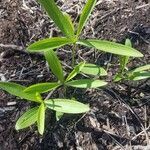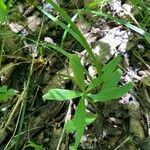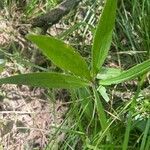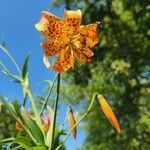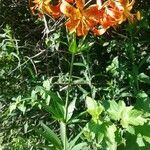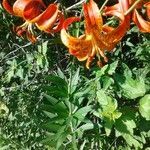Bulbs usually yellowish, rhizomatous, unbranched, 1.6–5.8 × 4.9–14.1 cm, 0.3–0.5 times taller than long, 2 years’ growth evident as annual bulbs, scaleless sections between these 2.6–6.2 cm; scales unsegmented, longest 1–3 cm; stem roots present or absent. Stems to 1.9 m. Buds rounded in cross section. Leaves in 4–12 whorls or partial whorls, 3–13 leaves per whorl, ± horizontal or ascending in sun, drooping at tips, 4.6–15.3 × 0.6–2.3 cm, 3.5–13.7 times longer than wide; blade narrowly elliptic, occasionally linear or slightly lanceolate, margins not undulate, apex acute, acuminate in distal leaves; principal and some secondary veins impressed adaxially, veins and margins noticeably roughened abaxially with tiny ± deltoid epidermal spicules, especially on proximal leaves. Inflorescences racemose, 1–11-flowered. Flowers ± pendent, not fragrant; perianth Turk’s-cap-shaped; sepals and petals reflexed 1/4–2/5 along length from base, yellow-orange or sometimes orange-yellow or orange proximally, red-orange distally, with maroon, often large spots, red-orange or occasionally red or orange-red abaxially, not distinctly clawed; sepals not ridged abaxially, 5.5–9.3 × 1.2–2 cm; petals 5.3–9.1 × 1.5–2.2 cm; stamens moderately exserted; filaments parallel at first, then ± widely spreading, diverging 13°–23° from axis, pale yellow-green; anthers magenta or occasionally pink-magenta, 0.6–1.3 cm; pollen orange-rust, sometimes orange, rust, or rust-brown; pistil 3.4–6.5 cm; ovary 1.5–2.9 cm; style red entirely or only distally; pedicel 11–22 cm. Capsules 2.8–5 × 1.5–2.6 cm, 1.4–2.8 times longer than wide. Seeds not counted. 2n = 24.
More
Much like no. 7 [Lilium superbum L.], but usually spiculate-scabrous along the margins of the lvs and on the veins beneath; anthers mostly 5–15 mm; 2n=24. Bogs, meadows, low woods, and wet prairies; w. N.Y. and s. Ont. to Man., s. to Tenn. and Ark. June, July.
